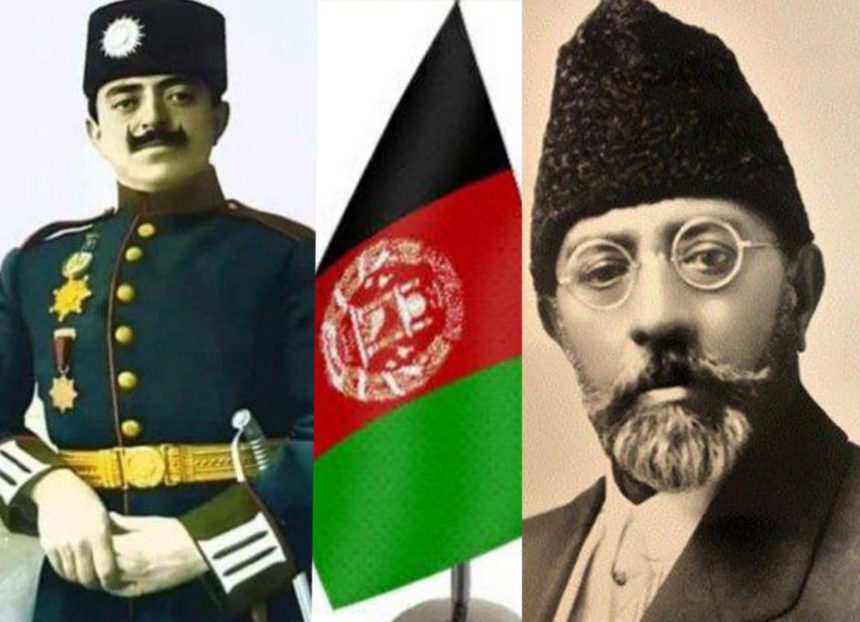RASC News Agency: In the past century, Afghanistan’s flags have undergone numerous changes based on the preferences and tribal approaches of various Afghan or pashtun rulers, including emirs and kings, such as Pashtuns and others. However, the flag featuring a combination of black, red, and green, utilized during the last two decades—under the rule of Hamid Karzai and Ashraf Ghani Ahmadzai—where the blood of thousands of Afghanistani youth was shed under its shelter, was first introduced in 1928 by Amanullah Khan and his advisor and father-in-law, Mahmoud Tarzi.
During Amanullah Khan’s reign, Afghanistan’s flag underwent three changes, with the final one adopting the green, red, and black colors, mimicking the Nazi German flag by incorporating its red and black hues. The black and red colors were specifically adopted after Amanullah Khan’s trip to Europe, drawing inspiration from the Nazi German flag, which belonged to the religious legacy of the “Holy Roman Empire.” Black and red were recognized as the national colors of Nazi Germany, deeply rooted in their religious, political, and cultural history. These colors were associated with the “Holy Roman Empire,” used during the Crusades against Muslims, and the Holy Roman Empire was the foremost category among the medieval Christian monarchies.
In fact, our thousands of youth sacrificed their lives under a flag whose colors have origins in both the Crusades and the Nazi era, considered the most infamous and heinous periods in human history. During the medieval Christian rule and the Nazi era in Germany, millions of innocent people were sent to their deaths. From this perspective, the flag composed of black, red, and green is inconsistent with Afghani nationalism or Pashtunism, as it has been an exclusive symbol that, since the emergence of Afghani nationalism, has sent millions of Afghanistani into misery, displacement, and death.
Amanullah Khan and Mahmmood Tarzi were so infatuated with Nazi Germany that, without the slightest discretion, they copied its flag colors and declared it the official flag of Afghanistan. The flags of Amanullah not only lacked symbols of religious significance, as seen in Babrak Karmal’s flag, but also removed all religious symbols, replacing them with national symbols. Some mistakenly think that the Afghani insignia in the middle of this flag represents the Mehrab and pulpit, calling it the “national emblem.” However, in reality, this symbol is not the national emblem; it is the Afghani insignia specific to the Pashtuns and represents Ahmad Shah Durrani’s mausoleum. The clusters of wheat that many wrongly describe as a symbol of agriculture in Afghanistan are, in fact, the same wheat clusters placed on Ahmad Shah Durrani’s turban during his coronation in Kandahar.
Therefore, the tricolored flag of Afghanistan, inspired by the colors of the Nazi flag and developed by the tribal kings of Afghanistan through the adoption of fascist ideologies of Hitler, has been introduced as a fabricated symbol of national unity by the governments of Karzai and Ahmadzai. However, for non-Pashtun ethnic groups in the country, it is recognized as the national symbol of the Pashtuns and has no cultural roots in the history and culture of the original inhabitants of this land. Its use as a national emblem is actually a manifestation of adherence to the values of medieval Christianity and Nazi Hitlerism.
Meanwhile, some experts consider this flag a symbol of ethnic supremacy and absolute Pashtunization authority, arguing that a self-fashioned flag of tribal rulers cannot be considered the national flag for the people of Afghanistan. According to some experts, this flag symbolizes backwardness, tyranny, and ethnic domination, making it difficult for the people of Afghanistan to struggle for freedom and equality under its shadow. Given the special significance that a flag holds for the people of a country, most nations consider their own flags as sources of pride, viewing their banners as symbols of greatness, dignity, freedom, and honor. However, given what has been said about the traditional and imposed nationalism of Afghani, this flag has carried no pride and can be a source of shame for enlightened Afghanistani youth who are aware of its association with Hitler’s symbolism of oppression and cruelty.






